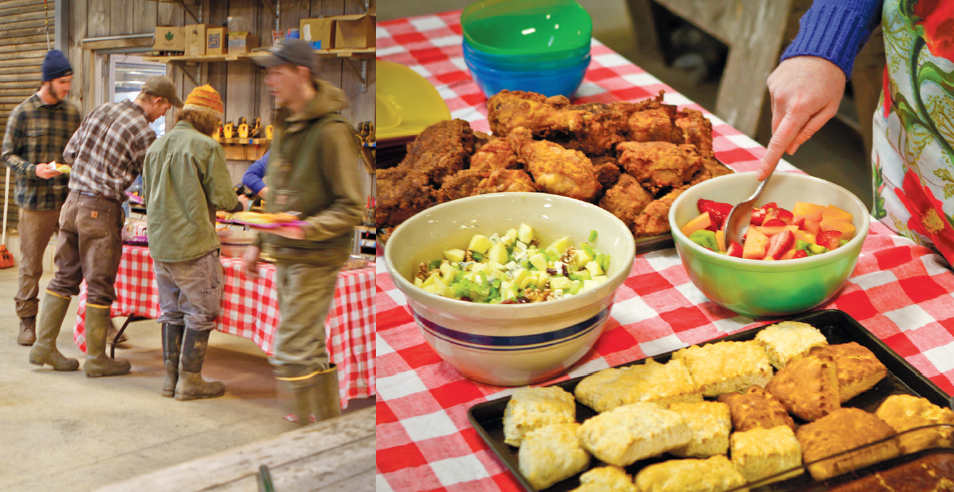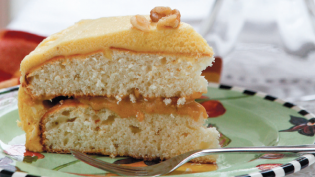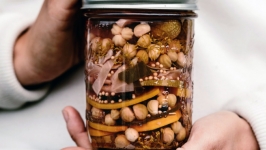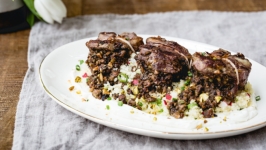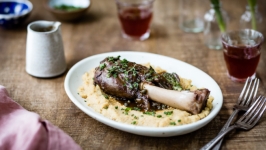Crew Lunch: Fueling a Pack of Hungry Sap Tappers
You have signed on to be a crew member of a large maple operation and are starting your first day of tapping trees. You arrive at the sugarhouse at 6:30 on a mid-January morning. It is five degrees outside as dawn is just beginning to light the sky.
Fill your pack with 20 pounds of gear including repair tools, spare batteries and, most importantly, a cordless drill. Layer yourself head to toe in cold-weather gear, get the day’s instructions and jump on a four-wheeler, following the rest of the crew up the logging roads.
When you reach the right spot in the woods, park, fill your pockets with taps, strap on your snowshoes and spread out through the forest. With the 20-pound pack on your back, trudge through deep snow over to your first tree, reach the drill up as high you can, drill a hole, hammer in the tap and attach the tubing.
Now repeat 400 times and you have just completed your first day at Thunder Basin Maple Works.
Though sugaring is known for being hard work, few have experienced just how demanding it can be. My husband, Eric, and I have a large maple operation with 67,000 taps spread across 1,000 acres of steep terrain on the western slopes of Mount Mansfield. It takes a crew of about 12 people roughly six weeks to tap all of the trees, depending on weather.
Some years, like the last, there was little snow and tapping went fairly quickly. Other years, such as 2011, there can be as much as 16 feet of snow in the forest—which makes it slow going, even with snowshoes. (There was so much snow in 2011 that sap lines you could duck under in the fall had to be stepped over by February.)
Once the trees are tapped, the rest of the season is dedicated to maintenance. All 700 miles of lines are walked and inspected over and over again as the crew looks for holes, breaks and other problems with the network of tubing. Nearly all of the walking is done up or down a steep slope with all of the necessary gear strapped on the crew’s bodies. The first season we were in operation, a year-end poll revealed that each crew member lost between five and 40 pounds.
The demographic of the crew ranges. We have had members as young as 17 and as old as 60. They are mostly male but we have had some women on the crew and are always hopeful that more will apply. We have one full-time manager, Dean Parent, and the rest are seasonal. The sugaring period dovetails nicely with the farming and construction season in Vermont so many workers are filling in the winter months before going back to regular farming or building jobs. No matter their age, though, they are among the most fit people you are likely to encounter.
Occasionally someone is hired who thinks they have the stamina, such as the PhD student who bragged of running marathons. They soon learn that the combination of steep hiking and constantly finding your balance in deep snow with a drill in hand can be a brutal workout that needs to be repeated every day up to seven days a week at the height of the season. (The PhD student lasted a couple weeks and then dropped out.)
I am the first to admit that I am not as tough as our crew. Occasionally I go up with them during tapping season and do my best to contribute a few hundred taps. I have other commitments, though, the most important being my two young children and the rest being a house, a writing career and a vegetable farm that starts as soon as the snow melts. Even if I had no other demands on my time, I am certain that for the daily exertion of the woods work, I am not as physically tough as these guys.
There is one way that I can contribute, however, and that is to make a huge feast, once a week. I have a degree from the French Culinary Institute in New York and some restaurant experience, and my strength lies in cooking a five-dish spread for 12 famished men in a couple of hours. The tradition started with my crew on the vegetable farm. Once a week I would gather veggies from the field and make a huge meal, changing the ethnic genre upon request.
I have downsized the farm considerably since we started sugaring and don’t have a summer crew anymore. But when we started the maple operation, my husband asked if I would start crew lunch again and I was glad to have something to contribute.
I use a lot of produce I grow here on the farm; there are usually onions, garlic, squash and potatoes stored in the basement. The freezer is also stocked with baggies of our corn, tomatoes and berries. With true lumberjack appetites coming in for lunch, there is no reason to show restraint on the menu. I aim for hearty, gooey, rich and fatty for the main dish. Beef stew and lasagna are favorites but occasionally I step it up and make something like braised chicken thighs with white wine, lemon and green olives. Thai food is another favorite.
There is always a large salad, several sides and usually a big layer cake to finish. Needless to say, when the sap starts running, I incorporate maple syrup in as many dishes as possible. Not being much of a baker, I make a loaf of bread in the bread machine and though it is never enough, it is usually done just in time to come out piping hot at lunchtime.
Over the years, the atmosphere at crew lunch has run from boisterous to dead quiet, depending on the mix of personalities. I join them for the meal, hoping to get to know the people who are integral to making our operation work. As the season progresses, I have found the appearance of the woods crew as a group gets wilder: Facial hair grows prolific and their winter gear gets torn up from the brambles and sticks hidden on the forest floor. Sometimes when I see them coming in together with their beards crusted in ice, I think all they need is an eye patch here and there and they would easily pass for a group of arctic pirates.
While we sit and share a meal together as the ice melts onto the sugarhouse floor, I learn bits and pieces of their lives and hope that we will always be able to continue this tradition of crew lunch. It is a pleasure to cook for the toughest guys in Vermont.
Thunder Basin Maple Cake
I am not a natural-born baker. My skills as a cook do not include the precision required to make refined desserts; I’m more of a little-of-this, little-of-that kind of chef. My lack of aptitude has not prevented me from trying, though, and one of my favorite things to present on the table is a big layer cake.
Although I only tried a couple times a year, I used to be atrociously bad at making them. The flavor was all right but the presentation was laughable. The cake part would be too crumbly or the frosting too dribbly. Or the frosting would be too hard and pull the cake apart upon spreading and the whole thing would look like finished compost on a plate. For a while, out of frustration, I would serve the cake and frosting separately, sort of like bread and butter. The guests really enjoyed custom-loading their cake with frosting, but I was missing the “Ta-dah!” moment that is so much fun with a finished layer cake.
The only way to improve was to practice but my 40-something metabolism was not going to do well with layer cake constantly hanging around the kitchen. Then I started cooking lunch for the crew. Once a week I got to make a huge layer cake that was appreciated by many without consequences to my waistline.
I finally found a few sponge cake recipes with good flavor that didn’t fall apart when frosted. I learned how to make frostings and glazes that held up beautifully. I felt so confident about my abilities that I went out on a limb and created an original cake. Like most baking recipes, this one is created from existing recipes that I modified to my liking. And so, with pride, I present Thunder Basin Maple Cake.


